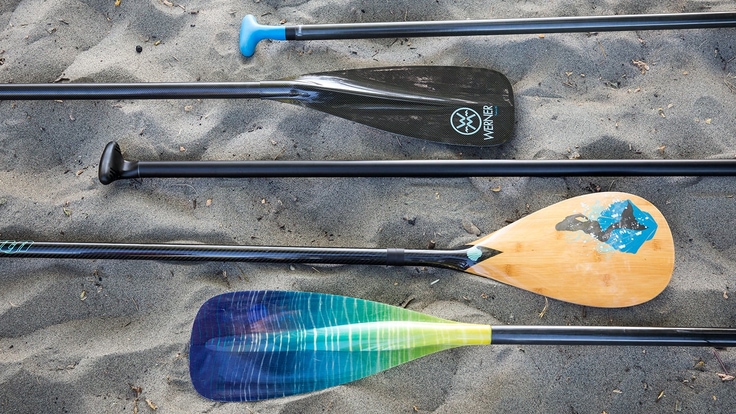You can buy the best board out there, but without a good paddle you won't get very far.
Getting a quality paddle that works well with your body and paddling style will make stand up paddle boarding (SUP) a bunch more fun. Does that mean you have to buy a top-of-the-line paddle? Not necessarily. To choose the right SUP paddle for you, consider these factors:
- Length: Getting the right size paddle is key to maintaining proper paddling form and efficiency.
- Material: The materials used to construct a SUP paddle play a role in determining the weight and stiffness of the paddle. Generally, a lightweight paddle is preferred, but keep in mind that you usually pay more for less weight.
- Blade size, shape and offset: The size, shape and offset of the paddle blade define how the blade moves through the water. You'll choose a blade based on the type of paddling you do, your body type and personal preference. Usually, the larger you are, the bigger you'll want your blade to be.
SUP Paddle Length
It's important to get a paddle that is the right length for you. A paddle that's too long will be cumbersome to use; one that's too short will require you to lean over in an awkward position to get the blade into the water.
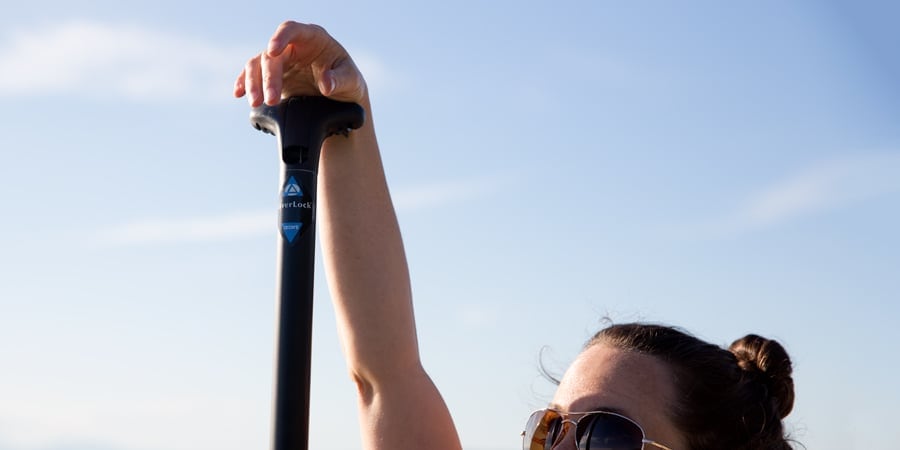
To choose the right size paddle for recreational touring:
- Stand the paddle up vertically so the tear-drop-shaped blade is touching the ground.
- Reach an arm up above your head and notice where it lands on the paddle.
- With a properly sized paddle, the T-grip handle will rest in the bend of your wrist. (If the paddle is adjustable, adjust the length of the shaft to fit.)
- If you're ordering a paddle online, add about 8-12 inches to your height and choose a paddle of that length.
If you'll be doing something other than recreational touring, such as surfing or racing, you may need a different length. SUP surfers usually choose a paddle that's a bit shorter than touring length, while racers typically go a bit longer.
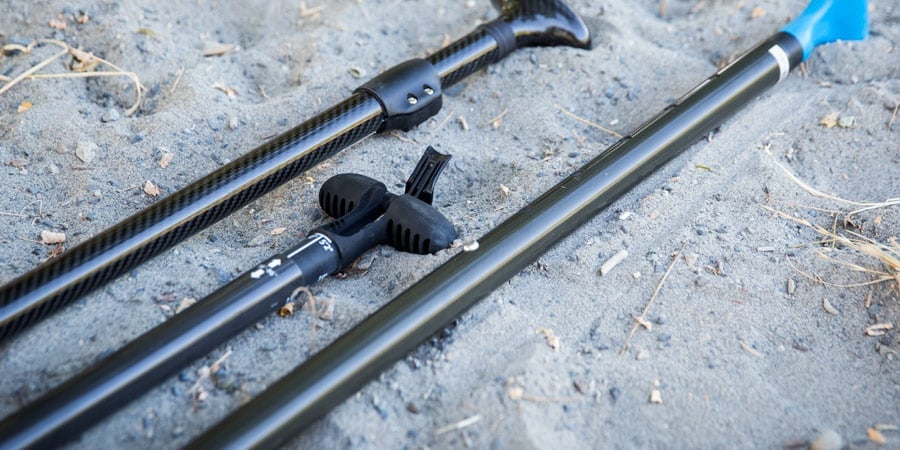
Adjustable-Length vs. Fixed-Length Paddles
Adjustable-length paddles are popular because of their versatility. They let you easily experiment to find what length works for you and you can fine-tune the length for surfing, touring or racing. Another plus is that you can share your paddle with shorter or taller friends and family members. Many manufacturers make the same paddle in a few different adjustment ranges, so make sure the one you select will meet your needs.
Fixed-length paddles: Some people prefer non-adjustable, fixed-length paddles because they tend to be lighter and stiffer because they lack the adjustment mechanism. Some fixed-length paddles are designed to be cut down so you can get the exact length you need. Before buying a fixed-length paddle, try out a few different lengths to really figure out what you like.
SUP Paddle Materials
In just two hours of paddling most people will take a couple thousand strokes. Lifting a heavy paddle that many times can quickly tire you out, which is why most experienced paddlers will invest in the lightest paddle they can afford. The weight of a SUP paddle is primarily determined by the materials used to make it
The material of your paddle will also determine how stiff it is. A stiff paddle is more efficient at transferring the power of your stroke.
While pondering your material choices, consider these points:
- Do you need a light paddle? If you're racing or setting out on long tours, you'll appreciate a light paddle. If you only paddle a few times each year, weight doesn't have to be your top concern.
- How much do you want to spend? Lightweight materials, like carbon and fiberglass, cost more than heavier ones, like aluminum and plastic.
- Stiff paddles can be jarring to your muscles and joints. If you have had previous shoulder, arm or wrist injuries, you may want a paddle with some flex.
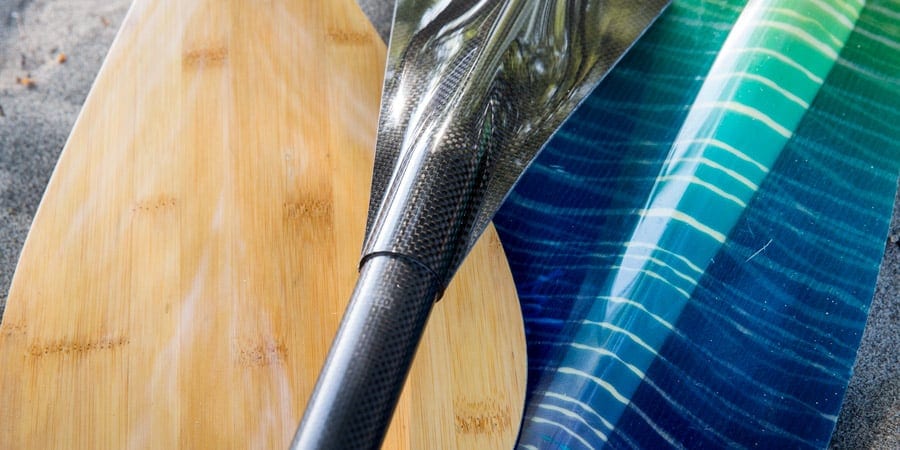
Here are the most common options for shafts and blades:
Plastic: Used in the blades and grips of entry-level paddles, plastic is durable and affordable. It's almost always paired with an aluminum shaft.
Aluminum: Used in the shaft of SUP paddles, aluminum is affordable and lightweight, but not as light or stiff as fiberglass or carbon. Aluminum shafts are frequently paired with plastic blades; these paddles are a great choice for beginner paddlers.
Fiberglass: An excellent lightweight choice, fiberglass is used in the shaft and/or blade of some SUP paddles. Fiberglass is fairly stiff, which makes it efficient at transferring the power of your stroke. But it is a bit less stiff than carbon fiber. A paddle made with fiberglass is often more expensive than aluminum/plastic, but more affordable than carbon fiber.
Carbon fiber: This is the lightest, stiffest material available, and often the most expensive. The weight savings can be worth the added cost if you're a frequent long-distance paddler. The stiffness of carbon fiber results in excellent power transfer from your muscles to the blade of the paddle. High-end paddles use carbon fiber throughout the shaft and blade, while more-affordable designs sometimes feature a composite construction, such as a blend of carbon and fiberglass or a carbon shaft paired with a fiberglass blade.
Wood: Some SUP paddles are made entirely from wood while others use only a veneer on the blade. Wood paddles are beautiful, but they can sometimes weigh and cost more than those made from other materials.
Blade Size, Shape and Offset
The blade is the part of the paddle that you dip into the water when you're taking a stroke. The size, shape and offset of the blade all affect how the paddle performs.
Blade Size

There's no hard and fast rule for determining exactly what size paddle blade you need. Over time, you'll probably develop a preference for a certain size blade based on the type of paddling you do and other factors, like your body type.
But, if you're brand new to SUP, use this guideline: The larger you are, the larger your blade can be. This is because bigger paddlers typically have the strength to pull a larger blade through the water. An easy way to compare blade sizes is to use the blade surface area measurement (given in square inches) that is provided on REI product pages.
Here are some approximate surface area recommendations based on body weight:
Small/medium body types (less than 150 lbs.): 80-90 sq. in.
Medium/large body types (150 - 200 lbs.): 90-100 sq. in.
Large/X large body type (200+ lbs.): 100-120 sq. in.
With these recommendations in mind, here are some additional things to think about:
- Large blades are more powerful: A large blade moves a lot of water, which allows you take powerful strokes to get your board up to speed quickly. If you're a SUP surfer, for example, you might like a larger blade (100-120 sq. in.) that will allow you to take a few powerful strokes in order to quickly position your board to catch a wave.
- Small blades are more efficient: A small blade moves less water with each stroke, but it's easier to pull the blade through the water than a larger blade, which means you use less effort with each stroke. A blade in the 80-90 sq. in. range might be an advantage if you're a SUP racer or long-distance tourer and you want to preserve energy for the long haul. A small blade is also a better choice if you like to paddle with a high cadence or if you need to be more gentle on your joints and muscles.
Blade Shape
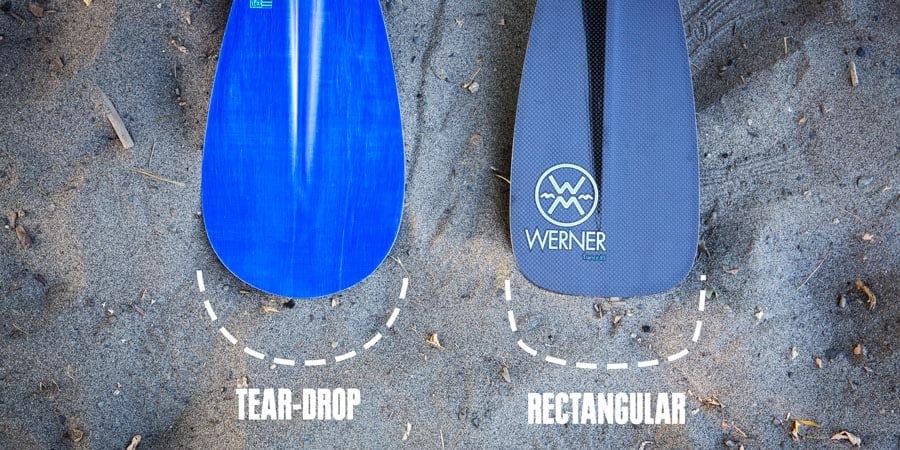
The shape of the blade can affect how the paddle moves through the water and how powerful the blade is. The performance differences between blade shapes can be subtle, but as you gain experience, you may develop a preference for one shape over another.
Tear-drop: This shape is widest at the bottom, which means that when you put the blade in the water, you're immediately pushing water with the majority of the blade's surface area. Using lots of surface area translates to a powerful stroke, which is sometimes preferred by SUP surfers and paddlers who enjoy a slower-cadence, more-powerful stroke.
Rectangular: Blades with a rectangular shape are narrower at the bottom than a tear-drop blade, which means less surface area is engaged when you first dip the blade in the water. Because of this, these blades can promote a gentler stroke and can be easier on your body. They also allow for a higher-cadence stroke.
Offset
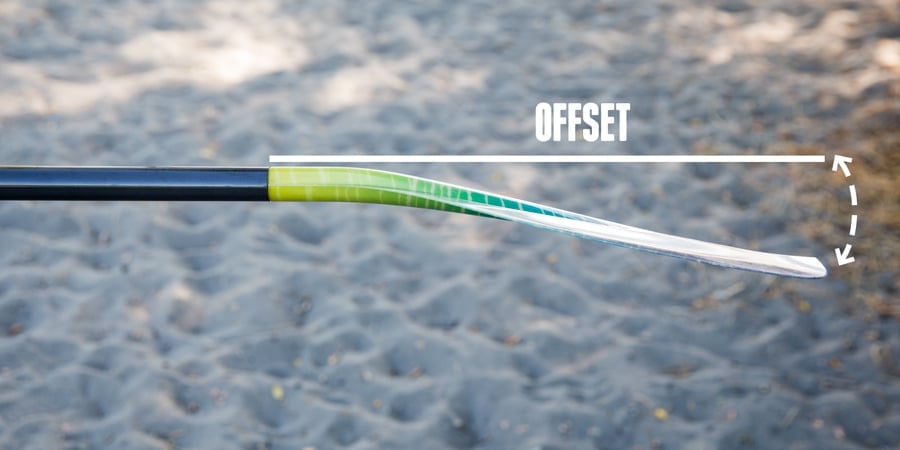
Offset describes the degree that the blade angles forward from the shaft. The size of that angle affects how vertical the blade is when it travels through the water, which in turn can affect how much power you get out of each stroke.
You don't need to spend much time scrutinizing offset angles unless you enjoy analyzing the finer details of your gear. That being said, here are some general offset recommendations based on different styles of paddling:
For SUP surfing: approximately 7 degrees
For all-around paddling/mixed use: approximately 10 degrees
For SUP racing: approximately 12 degrees
You can often find offset angle listed on the REI.com product pages or the paddle manufacturer's website.
